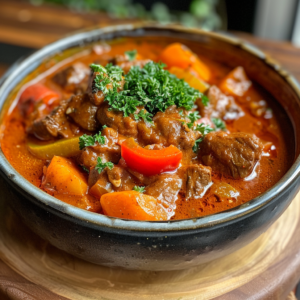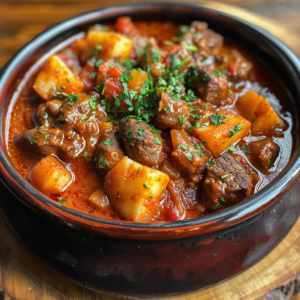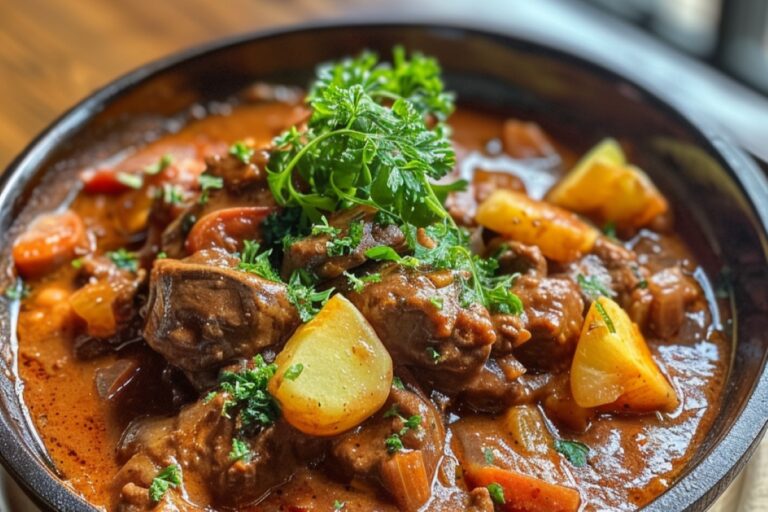Discover the Richness of Hungarian Goulash
Hungarian goulash is more than just a stew; it’s a national treasure that epitomizes the rich culinary heritage of Hungary. Known for its deep, paprika-driven flavors and comforting qualities, goulash has a history as rich as its taste. This article delves into the authentic makeup of Hungarian goulash, exploring the traditional ingredients and cooking methods that make it a beloved dish across the globe. Join us as we uncover the secrets to crafting the perfect bowl of this hearty stew.
Understanding Hungarian Goulash
Hungarian goulash, or Gulyás as it’s called in Hungary, is a symbol of the nation’s history and a staple in its cuisine. It is a prime example of how a few simple ingredients, cooked properly, can yield an incredibly satisfying dish.
Authentic Hungarian Goulash Recipe
Name: Traditional Hungarian Goulash (Gulyás)
Summary: This authentic recipe brings the essence of Hungarian kitchens to your dining table, featuring a robust blend of meat, vegetables, and lots of paprika for that signature flavor.
Servings: 4
Advanced Servings: Can be doubled or tripled, maintaining the ingredient proportions to cater to larger groups.
Prep Time: 20 minutes
Cook Time: 1 hour 30 minutes
Custom Time Label: Optional Marinating Time
Custom Time: Overnight (if marinating meat for enhanced flavor)
Total Time: Approximately 2 hours (excluding marinating time)
Categories:
- Courses: Main course
- Cuisines: Hungarian
- Keywords: Hungarian goulash, traditional goulash, Hungarian cuisine
Equipment: - Amount: 1
- Name: Dutch oven
- Notes: A heavy pot is crucial for even cooking and developing flavors.
Ingredients: - Amount and Unit: 1.5 pounds of beef, 2 large onions, 2 red bell peppers
- Name: Beef chuck, onions, bell peppers, tomatoes, garlic, Hungarian paprika
- Notes: Quality Hungarian paprika is essential; it should be sweet not spicy, lending a rich color and flavor.
Instructions:
- Begin by heating oil in your Dutch oven, then sauté the onions until golden.
- Add the beef and sear until browned, enhancing the stew’s savory base.
- Integrate the bell peppers and tomatoes, followed by a generous amount of paprika, stirring constantly to prevent the spice from burning.
- Pour in enough water or beef broth to cover the ingredients, bringing it to a gentle simmer.
- Cook slowly until the meat is tender and the stew thickens to your liking.
- Metadata for Google: Learn how to make authentic Hungarian goulash with traditional ingredients and methods.
- Nutrition:
- Calories: Approximately 500 kcal per serving
Notes:
- Calories: Approximately 500 kcal per serving
- The key to perfect goulash lies in its simplicity and the quality of paprika used. Resist the urge to add too many spices or ingredients.
By following this traditional recipe, you can experience a taste of Hungary’s culinary pride. For more detailed insights, check out Hungarian Goulash – A Traditional Culinary Guide on SkinyTaste. In the following sections, we’ll explore the individual ingredients that contribute to the unique flavor profile of Hungarian goulash, ensuring you have all the knowledge needed to replicate this dish authentically.
Key Ingredients and Their Roles in Hungarian Goulash
To fully appreciate the depth of flavor in Hungarian goulash, it’s essential to understand the roles of its core ingredients. Each component contributes unique qualities that, when combined, create a dish that’s rich in history and taste.

The Signature Ingredient: Paprika
Paprika is the heart of Hungarian goulash, providing color, flavor, and warmth. Here’s a closer look at why this spice is so crucial:
Table: Types of Paprika Used in Goulash
| Type of Paprika | Characteristics | Why It’s Used in Goulash |
|---|---|---|
| Sweet Paprika | Mild, sweet, with vibrant color | Adds depth without overpowering heat |
| Smoked Paprika | Smoky flavor, deep red hue | Gives a subtle smokiness, enhancing the stew’s rustic feel |
| Hot Paprika | Spicy with a robust flavor | Used sparingly to add a heat kick, if desired |
Essential Vegetables and Their Functions
Vegetables play a critical role in building the stew’s complex flavors and textures.
Table: Vegetables in Hungarian Goulash
| Vegetable | Role in Goulash | Nutritional Benefit |
|---|---|---|
| Onions | Foundation for flavor base, sweetens as it cooks | High in antioxidants, aids digestion |
| Bell Peppers | Adds sweetness and texture | Rich in Vitamin C and antioxidants |
| Tomatoes | Provides acidity and body | Source of Vitamin C and potassium |
| Potatoes | Thickens the stew, adds heartiness | Provides carbohydrates and fiber |
| Carrots | Sweetness and color | High in beta-carotene and fiber |
Meats: Choosing the Right Cut
The choice of meat can greatly affect the texture and flavor of the goulash.
Table: Preferred Meats for Goulash
| Meat Type | Characteristics | Cooking Tips |
|---|---|---|
| Beef Chuck | Marbled with fat, becomes tender when slow-cooked | Best cut for slow-cooking due to fat content which renders into tender, flavorful bites. |
| Pork Shoulder | Slightly fattier, rich flavor | Alternative to beef, it requires similar slow-cooking to achieve tenderness. |
By carefully selecting and using these ingredients, you can create a Hungarian goulash that is both authentic and deeply satisfying. For insights on another classic European dish, check out this guide on Veal Piccata, a traditional Italian recipe. Understanding how each element contributes to the dish not only enhances your cooking experience but also allows you to appreciate the cultural significance behind this beloved Hungarian stew. In the next section, we’ll delve into the specific cooking techniques that maximize the potential of these ingredients.
Cooking Techniques and Serving Suggestions for Hungarian Goulash
Perfecting Hungarian goulash involves mastering a few key cooking techniques that highlight the flavors and textures of its ingredients. Understanding these methods will help you create a dish that’s true to its roots and satisfying to all who taste it.

The Art of Slow Cooking
Slow cooking is essential in making traditional Hungarian goulash. This method allows the flavors to meld beautifully and the meat to become fork-tender, which is characteristic of an authentic goulash.
- Start with a Sauté: Begin by sautéing onions in fat until they’re golden. This base layer of flavor sets the stage for the entire dish.
- Browning the Meat: Sear the meat until it’s caramelized on all sides. This step not only enhances flavor through the Maillard reaction but also seals in the juices of the meat.
- Deglazing the Pan: After browning the meat and vegetables, deglaze the pan with a splash of water or broth. This technique lifts the fond (browned bits) off the bottom of the pan, incorporating those rich flavors into the broth.
- Simmering: Once all ingredients are combined in the pot, bring the mixture to a simmer. The gentle, slow simmer is crucial for developing a rich, deep flavor and tenderizing the meat.
Tips for Achieving the Best Flavor
- Use Quality Paprika: The type of paprika used can make or break your goulash. Authentic Hungarian paprika is preferred for its color and flavor.
- Balance the Flavors: Adjust the seasoning as the goulash cooks, especially after the initial simmer. The slow cooking process can change flavor intensity, so it’s important to taste and adjust accordingly.
- Let It Rest: Allowing the goulash to sit for a few hours or even overnight can enhance its flavors. Reheat it slowly on the stove before serving.
Serving Hungarian Goulash
Hungarian goulash is traditionally served with a side of bread or dumplings. Here are some suggestions for presenting and enhancing your goulash:
- With Crusty Bread: Serve goulash with a slice of hearty, crusty bread to soak up the delicious sauce.
- Dumplings or Spaetzle: These are perfect for absorbing the goulash’s rich flavors and add a textural contrast.
- Add a Dollop of Sour Cream: A common Hungarian serving suggestion is to top goulash with a bit of sour cream, which adds a creamy texture and a slight tang, balancing the paprika’s robust flavor.
By employing these techniques and suggestions, you can create a Hungarian goulash that not only tastes great but also respects the culinary traditions from which it came. In the final part of this article, we will explore common questions about Hungarian goulash, providing you with all the knowledge to confidently cook this iconic dish.
FAQs and Expert Tips for Perfect Pulled Pork
Navigating the nuances of making perfect pulled pork can raise many questions, especially for those new to this dish. This section aims to address common inquiries with expert advice to ensure every batch of pulled pork you make is a success.

Frequently Asked Questions About Pulled Pork
To help clarify the process and provide additional guidance, here’s a table summarizing common queries about making pulled pork along with their answers:
Table: Common Questions About Making Pulled Pork
| Question | Answer |
|---|---|
| What is the ideal temperature for cooking pulled pork? | Low and slow is the key; aim for about 225°F (107°C) to ensure tender, juicy meat. |
| How long should I cook pulled pork? | Typically, you should cook it for about 1 to 1.5 hours per pound at 225°F. |
| Can I cook pulled pork in a slow cooker? | Yes, a slow cooker is great for pulled pork. For optimal outcomes, simmer gently for 8 to 10 hours. |
| What are the signs that pulled pork is done? | Pulled pork is done when it reaches an internal temperature of 195-205°F and shreds easily. |
| What methods can I use to enhance the taste of my pulled pork? | Use a spice rub before cooking and consider injecting the meat with a marinade for more depth. |
Tips for Perfect Pulled Pork
Here are additional tips from culinary experts to help you master the art of pulled pork:
Expert Advice for Enhancing Your Pulled Pork
- Preparation: Apply a generous amount of rub to your pork the night before to allow the flavors to penetrate deeply.
- Moisture Management: During long smoking sessions, keep the pork moist by spraying it with apple juice or cider vinegar every hour.
- Resting the Meat: After cooking, let the pork rest for at least 30 minutes before pulling to redistribute the juices throughout the meat.
Best Practices for Storage and Reheating
Maintaining the quality of your pulled pork, even after it’s been cooked, is crucial. Here’s how to store and reheat it effectively:
Table: Storing and Reheating Pulled Pork
| Storage Tip | Details |
|---|---|
| Refrigeration | Store in an airtight container for up to 3-4 days. |
| Freezing | Freeze in sealed bags for up to 3 months. |
| Reheating | Reheat slowly in a covered pot with a bit of added moisture to prevent drying out. |
By adhering to these FAQs and expert tips, you can ensure your pulled pork is not only flavorful and tender at first serving but also delicious in subsequent meals. Whether you’re a novice or a seasoned cook, these insights will enhance your pulled pork preparation and enjoyment.
FAQs and Practical Tips for Making Hungarian Goulash
Navigating the intricacies of preparing authentic Hungarian Goulash can pose several questions, especially for those new to this traditional dish. This section aims to address some of the most common inquiries and provide practical tips to ensure your goulash is as authentic and delicious as possible.
Frequently Asked Questions About Hungarian Goulash
To aid in demystifying the process and offering additional guidance, here’s a table summarizing common questions about making Hungarian Goulash along with their answers:
Table: Common Questions About Making Hungarian Goulash
| Question | Answer |
|---|---|
| What cut of meat works best for goulash? | Beef chuck or shank is ideal because it’s flavorful and tenderizes beautifully when slow-cooked. |
| Is it necessary to use Hungarian paprika? | Yes, Hungarian paprika is preferred for its authentic flavor and color. |
| Can goulash be made in a slow cooker? | Absolutely, though traditional methods involve simmering in a pot, slow cookers are a great modern alternative. |
| How long should goulash be cooked? | Goulash is best when simmered slowly for at least 1.5 to 2 hours to develop depth of flavor. |
| What are traditional sides served with goulash? | Goulash is traditionally served with bread, egg noodles, or potatoes. |
Tips for Perfect Hungarian Goulash
Here are some expert tips that can help you achieve the best results when preparing Hungarian Goulash:
Expert Cooking Tips
- Paprika Usage: Add paprika off the heat to prevent it from burning, which can introduce a bitter flavor.
- Simmer Slowly: Allow the goulash to simmer gently. Rapid boiling can make the meat tough.
- Fresh Ingredients: Use fresh, high-quality ingredients for the best flavor, especially with the vegetables and spices.
Best Practices for Storage and Reheating
Maintaining the quality of your goulash, even after it’s cooked, is essential. Here’s how to store and reheat it:
Table: Storing and Reheating Hungarian Goulash
| Storage Tip | Details |
|---|---|
| Refrigeration | Store in the refrigerator in an airtight container for up to 3 days. |
| Freezing | Freeze in airtight containers for up to 3 months. |
| Reheating | Reheat on the stove over low heat, adding a little broth if necessary to prevent drying out. |
These FAQs and tips are designed to help you navigate the process of making Hungarian Goulash, ensuring each batch is delicious and authentic. Whether you’re a seasoned chef or a curious novice, these insights will enrich your cooking experience and bring a taste of Hungary to your kitchen.
